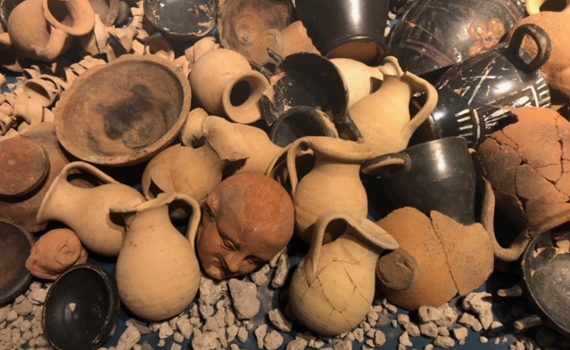They are two sites of great importance in the reconstruction of the Stabian area settlement history and the understanding of its role in pre-Roman times.
The necropolis of Madonna delle Grazie contains about 300 tombs spread over an area of around 15,000m2, dating back to a period spanning from the second half of the 7th century B.C. to the end of the 3rd century B.C.. This site testifies to the earliest settlements in the area and provides valuable information on the inhabitants of the ancient towns and villages around Pompeii.
The site of Privati, on the other hand, is proof of a side of Stabian history as yet unknown. It is a sanctuary that was erected outside the city in the second half of the 4th century B.C.
It was built on a terrace on the Lattari Mountains sloping down panoramically over the Gulf of Stabiae. In ancient times, it marked the southern boundary of Stabiae and it was in a strategic position to control the routes connecting the Sarno Valley and the Sorrento-Amalfi area. At the centre of the terrace ledge was a large pit with votive offerings, often intentionally broken to pieces before being left there mixed with burnt earth and animal bones. Some of the offerings, ranging from ceramic and terracotta statuettes to antefixes, are proof of the strong link of the god worshipped here and the connection to women and the watching over of fertility and childbirth. The sanctuary was probably part of a network connecting various places of worship along the Sorrento peninsula, from the Doric Temple in Pompeii to the Athenaion on the Punta della Campanella.
Among the kinds of burials found in the necropolis of Madonna delle Grazie there are pit graves or tumuli covered with stones or roofing tiles. The displayed objects outline the identity of the deceased and prove that wine had arrived in the area thanks to connections with the Greeks and Etruscans. Between the end of the 7th and the beginning of the 6th century B.C. there were deep transformations in the settlements of area due to the arrival of new populations, such as the Etruscans. At that time in fact, partially due to the arrival of these foreign populations, the inhabitants of the most inland areas of the Sarno plain and the Lattari Mountains ventured as far as the Gulf of Naples and established new contacts. The necropolis of Madonna delle Grazie helps recount this complex phase of transformation.
Access to the exhibition is included in the ticket to the excavations.


